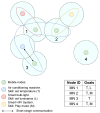A Novel Routing Scheme for Creating Opportunistic Context-Virtual Networks in IoT Scenarios
- PMID: 31010182
- PMCID: PMC6515370
- DOI: 10.3390/s19081875
A Novel Routing Scheme for Creating Opportunistic Context-Virtual Networks in IoT Scenarios
Abstract
The massive amount of traffic required by the emerging Internet of Things (IoT) paradigm can be supported by the imminent arrival of 5G next-generation networks. However, the limited capacity of resources in IoT nodes, e.g., battery lifetime or buffer space, opens a challenge to be taken into account when proposing new routing solutions on IoT scenarios with intermittent connectivity. In this paper, we propose the concept of Opportunistic Context-Virtual Networks (OCVNs). The novelty of this approach is to create virtual groups of nodes that share interests in common for routing purposes. Therefore, only the nodes that are interested in the content of the messages that are flowing throughout the network are used as relaying nodes, providing their own resources for the sake of the communication. By leveraging the use of store-carry-and-forward mechanisms, a novel routing algorithm is proposed and evaluated over two realistic scenarios. Experimental results reveal that our solution outperforms other well-known opportunistic routing algorithms in terms of delivery probability and overhead ratio, while resource usage of relaying nodes is significantly reduced.
Keywords: Internet of Things; contextual information; opportunistic networks; routing algorithms.
Conflict of interest statement
The authors declare no conflict of interest.
Figures













References
-
- Cisco Cisco Visual Networking Index: Global Mobile Data Traffic Forecast Update. [(accessed on 19 April 2019)]; Available online: http://www.gsma.com/spectrum/wp-content/uploads/2013/03/Cisco_VNI-global....
-
- Cisco Cisco Visual Networking Index: Forecast and Methodology, 2015–2020. [(accessed on 19 April 2019)]; Available online: http://www.cisco.com/c/dam/en/us/solutions/collateral/service-provider/v....
-
- Perera C., Liu C.H., Jayawardena S., Chen M. Context-aware Computing in the Internet of Things: A Survey on Internet of Things from Industrial Market Perspective. arXiv. 20151502.00164
-
- Bernbo S. The Internet of Things Demands a New Data Architecture. [(accessed on 19 April 2019)]; Available online: https://datacenterpost.com/internet-things-demands-new-data-architecture/
-
- Borgia E., Bruno R., Passarella A. Making opportunistic networks in IoT environments CCN-ready: A performance evaluation of the MobCCN protocol. Comput. Commun. 2018;123:81–96. doi: 10.1016/j.comcom.2018.03.005. - DOI
Grants and funding
LinkOut - more resources
Full Text Sources

